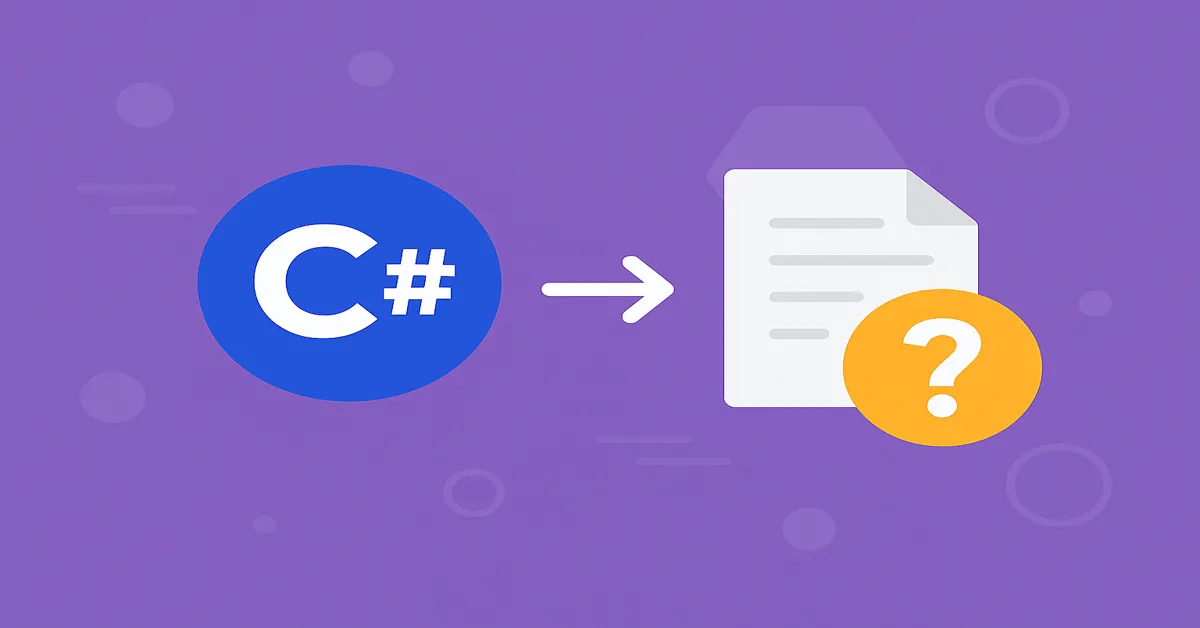In the evolving landscape of software development, C# stands out as one of the most enduring and versatile programming languages. Designed by Microsoft and deeply integrated into the .NET ecosystem, C# is used in everything from enterprise applications to web APIs, game development, cloud computing, and even IoT systems – Interview Questions of C#.
As C# continues to mature and expand its reach, companies across industries continue to prioritize it in their technology stacks. Consequently, C# remains a cornerstone of technical interviews, particularly for roles that touch on backend development, Windows applications, or full-stack engineering in Microsoft-heavy environments.
This article offers a curated, detailed, and updated list of the 30 most commonly asked C# interview questions, aimed at both fresh graduates and experienced professionals. We go beyond rote definitions, presenting insights and context behind the questions—just like an article from the New York Times might explore not just what, but also why.
1. What is C# and how does it differ from other programming languages?
C# is an object-oriented, type-safe, and managed programming language developed by Microsoft as part of its .NET platform. It is similar to Java in syntax but integrates more tightly with Windows and offers modern features such as LINQ, async/await, and value types. Unlike C++, C# does not support multiple inheritance of classes but supports interfaces and memory safety through garbage collection.
2. What is the Common Language Runtime (CLR)?
The CLR is the virtual machine component of .NET. It manages memory, thread execution, code safety, and other system services. When C# code is compiled, it’s translated into Intermediate Language (IL), which the CLR then just-in-time compiles to native code at runtime.
3. What is the difference between value types and reference types?
- Value Types: Stored in the stack, hold data directly (e.g., int, float, struct).
- Reference Types: Stored in the heap, reference a memory location (e.g., class, string, object).
Understanding this distinction is critical for memory management and performance optimization.
4. What are the main access modifiers in C#?
C# includes the following access modifiers:
publicprivateprotectedinternalprotected internalprivate protected
These control visibility of classes, methods, and properties across assemblies and inheritance hierarchies.
5. What is the difference between == and .Equals()?
== compares references by default unless overridden (e.g., in value types like int)..Equals() is a method intended for content comparison. For example, two strings with identical characters may return true with .Equals() even if they are different objects in memory.
6. What is boxing and unboxing in C#?
Boxing is the process of converting a value type to an object (reference type), while unboxing extracts the value type from the object. This operation involves memory allocation and can affect performance.
csharpCopyEditobject obj = 123; // Boxing
int num = (int)obj; // Unboxing
7. What is the difference between const, readonly, and static?
const: Compile-time constant, value must be assigned at declaration.readonly: Runtime constant, value can be assigned in constructor.static: Shared across all instances of a class.
Each is useful in different scenarios of data immutability and class-level design.
8. Explain the concept of inheritance in C#.
Inheritance allows a class to acquire properties and behaviors (methods) from another class using the : syntax. C# supports single inheritance and multiple interface inheritance.
csharpCopyEditclass Animal { public void Speak() => Console.WriteLine("Sound"); }
class Dog : Animal { }
9. What is polymorphism in C#?
Polymorphism enables the same method to behave differently based on the object calling it. This is achieved via:
- Compile-time polymorphism: Method overloading.
- Runtime polymorphism: Method overriding with
virtualandoverridekeywords.
10. What is encapsulation and why is it important?
Encapsulation is the practice of restricting direct access to an object’s data, typically through private fields and public properties or methods. It promotes modularity and protects object integrity.
11. What are interfaces and how are they used in C#?
Interfaces define a contract without implementation. A class that implements an interface agrees to implement all its members.
csharpCopyEditinterface IAnimal { void Speak(); }
class Dog : IAnimal { public void Speak() => Console.WriteLine("Bark"); }
Interfaces support multiple inheritance, making them key to flexible, decoupled architectures.
12. What is dependency injection (DI)?
DI is a design pattern where an object receives its dependencies from external sources rather than creating them internally. In .NET Core, built-in DI support encourages better testability and maintainability.
13. What is the difference between abstract class and interface?
- Abstract Class: Can include implementations, fields, constructors.
- Interface: Only method signatures and properties (C# 8+ allows default implementations).
Use abstract classes when you need base functionality; interfaces for behavior-only contracts.
14. Explain async and await in C#.
async and await keywords support asynchronous programming. They allow long-running tasks (like I/O operations) to run without blocking the main thread.
csharpCopyEditpublic async Task<string> GetDataAsync() {
var response = await httpClient.GetAsync("api/data");
return await response.Content.ReadAsStringAsync();
}
15. What is LINQ?
LINQ (Language Integrated Query) provides query syntax integrated into C#. It allows developers to write queries against arrays, collections, and databases in a type-safe manner.
csharpCopyEditvar results = items.Where(i => i.IsActive).ToList();
16. What are delegates in C#?
A delegate is a type-safe function pointer. It allows methods to be passed as parameters or stored.
csharpCopyEditpublic delegate void Notify();
Notify notify = SendEmail;
17. What is an event in C#?
An event is a wrapper over a delegate, used for publisher-subscriber scenarios (e.g., button clicks, status updates). It restricts external classes from invoking the delegate.
18. What is exception handling in C#?
C# handles runtime errors using try-catch-finally blocks. You can also throw custom exceptions for business logic validation.
csharpCopyEdittry {
// risky code
} catch (Exception ex) {
// handle
} finally {
// cleanup
}
19. What is the difference between throw and throw ex?
throw preserves the original stack trace.throw ex resets the stack trace, making debugging harder. Always prefer throw alone in a catch block.
20. What is a sealed class in C#?
A sealed class cannot be inherited. This is often used for security or design constraints.
csharpCopyEditsealed class BankAccount { }
21. What is the var keyword?
var enables implicit typing, meaning the compiler infers the type at compile time. It enhances readability but should not compromise clarity.
csharpCopyEditvar message = "Hello"; // infers string
22. What is a nullable type?
Nullable types allow value types to represent null.
csharpCopyEditint? score = null;
Helpful in database interaction and optional value scenarios.
23. What is the difference between ref and out parameters?
ref: Must be initialized before passed.out: Must be assigned inside the method before use.
Both allow passing by reference, but serve different use cases.
24. What is the purpose of yield return?
Used in iterators to return items one at a time, lazily.
csharpCopyEditpublic IEnumerable<int> GetEven() {
for (int i = 0; i < 10; i++)
if (i % 2 == 0)
yield return i;
}
25. What is garbage collection in .NET?
The CLR automatically reclaims unused memory through garbage collection. It tracks object references and frees memory when objects are no longer accessible, reducing memory leaks and manual cleanup.
26. What are extension methods?
Allow developers to “add” methods to existing types without modifying them. Often used with LINQ and utility functions.
csharpCopyEditpublic static class StringExtensions {
public static bool IsNullOrEmpty(this string str) =>
string.IsNullOrEmpty(str);
}
27. What is a static constructor?
A constructor that runs once per type (not per instance). It’s used to initialize static members.
csharpCopyEditstatic MyClass() {
// initialize once
}
28. What is the difference between shallow copy and deep copy?
- Shallow Copy: Copies object references.
- Deep Copy: Recursively copies all referenced objects as new instances.
Deep copies are crucial for preventing unintended shared state.
29. What are generics in C#?
Generics provide type safety without sacrificing performance or reusability.
csharpCopyEditpublic class Repository<T> { }
Common in collections (List<T>) and custom data structures.
30. What is the dynamic keyword?
dynamic defers type checking to runtime. Useful in interop scenarios (e.g., COM, JSON), but reduces compile-time safety.
csharpCopyEditdynamic obj = GetJson(); // no IntelliSense
Final Thoughts
Interviewers ask these C# questions not just to test your memory, but to evaluate your understanding of the language’s architecture, philosophy, and best practices. Mastery of these topics reflects not just academic knowledge, but also readiness for production-level software development.
Acing a C# interview isn’t just about knowing syntax—it’s about demonstrating that you can build maintainable, efficient, and scalable systems. These 30 questions form the foundation. Understand them deeply, and you’ll walk into your next interview with confidence and clarity.
Read:
Using Google Cloud Pub/Sub with C# for Real-Time Messaging
C# and Google Cloud Firestore: Building a Serverless NoSQL App
Leveraging Azure AI Services with C#: A Step-by-Step Tutorial
Getting Started with ML.NET: Building Your First Machine Learning Model in C#
FAQs
1. Are these C# interview questions suitable for both beginners and experienced developers?
Yes.
The list includes a mix of foundational questions (e.g., value vs. reference types, inheritance, access modifiers) and advanced topics (e.g., async/await, dependency injection, LINQ, generics). Beginners can use them to solidify core concepts, while experienced developers can review them to prepare for technical interviews and system design discussions.
2. How in-depth should I go when answering these questions in an interview?
Focus on clarity and practical understanding. For core concepts like polymorphism or async/await, interviewers often appreciate:
- A clear definition
- A code example
- A real-world use case
Don’t just recite textbook definitions—demonstrate that you understand how and why the concept is used in real projects.
3. Should I memorize answers to these C# interview questions?
No.
Understanding trumps memorization. While it’s useful to rehearse terminology, employers are more interested in how you apply concepts. Practicing with real code, building small sample projects, and explaining concepts aloud will build authentic fluency.
4. Do interviewers expect knowledge of the latest C# features (e.g., C# 10 or 11)?
Increasingly, yes—especially at companies using the latest .NET versions. Stay current with features like:
- Record types
- Pattern matching
- Top-level statements
- Minimal APIs
While not always required, familiarity with modern C# syntax shows that you’re keeping your skills up-to-date.
5. How can I practice these C# interview questions more effectively?
Here are some effective methods:
- Write code snippets for each answer using Visual Studio or VS Code.
- Use platforms like LeetCode or HackerRank for algorithm-based C# questions.
- Conduct mock interviews with peers or mentors.
- Turn each question into a blog post to reinforce your learning and build a portfolio.











